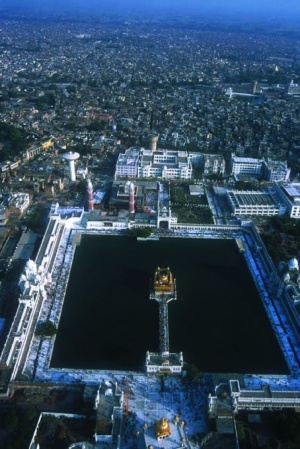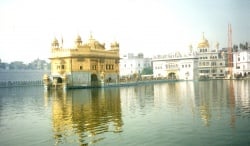Template:Today's featured article: Difference between revisions
No edit summary |
No edit summary |
||
| Line 1: | Line 1: | ||
[[Image: | [[Image:Harimandar sahib overview.jpg|thumb|Bird's eye view of Harimandir Sahib and Amritsar|right]] | ||
'''Harimandir Sahib:''' Literally "Temple of God."; Punjabi | |||
A Gurdwara of historical, spiritual, and emotional significance to Sikhs, called Harimandir Sahib in [[Punjabi]]. [[Guru Amar Das]] first conceived of it, although construction did not begin until [[Guru Ram Das]] became the Guru. [[Maharaja Ranjit Singh]] had the structure plated with gold in the early 19th century for the first time. During 2003, the gold plating was replaced with new gold. In 1604, the recently compiled [[Adi Granth]] was housed here for the first time. The Fifth Guru, [[Guru Arjan Dev]] ji sat on the floor with the rest of the congregation while the Adi Granth was place on a high platform or [[Takhat]]. The Indian army attacked this beautiful complex in June 1984 causing severe damage to the [[Akal Takhat]] building complex. | |||
[[Image:gtbss001.jpg|thumb|250px|right|The Golden Temple|left]] | |||
=== | ===Background=== | ||
''Harimander Sahib'' is the most famous [[Sikh]] temple or [[Gurdwara]]. It is also called the Golden Temple in English because of the gold plating that covers most of its surface. This Gurdwara is found in the holy city of [[Amritsar]] in [[Punjab]] in North West [[India]] and is the sacred and the most visited of the many historic Sikhs shrines found in [[India]] and [[Pakistan]]. This striking building was built by the [[Guru Arjan]] Dev, the fifth Guru of the Sikhs. | |||
'''[[Harimandir_Sahib|....Continued]]''' | |||
Revision as of 14:17, 2 May 2005
Harimandir Sahib: Literally "Temple of God."; Punjabi
A Gurdwara of historical, spiritual, and emotional significance to Sikhs, called Harimandir Sahib in Punjabi. Guru Amar Das first conceived of it, although construction did not begin until Guru Ram Das became the Guru. Maharaja Ranjit Singh had the structure plated with gold in the early 19th century for the first time. During 2003, the gold plating was replaced with new gold. In 1604, the recently compiled Adi Granth was housed here for the first time. The Fifth Guru, Guru Arjan Dev ji sat on the floor with the rest of the congregation while the Adi Granth was place on a high platform or Takhat. The Indian army attacked this beautiful complex in June 1984 causing severe damage to the Akal Takhat building complex.
Background
Harimander Sahib is the most famous Sikh temple or Gurdwara. It is also called the Golden Temple in English because of the gold plating that covers most of its surface. This Gurdwara is found in the holy city of Amritsar in Punjab in North West India and is the sacred and the most visited of the many historic Sikhs shrines found in India and Pakistan. This striking building was built by the Guru Arjan Dev, the fifth Guru of the Sikhs.


